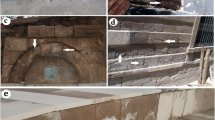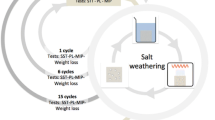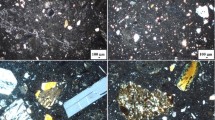Abstract
We performed a comparative study of the effectiveness of ethyl silicate (TEOS) and dibasic ammonium phosphate (DAP) on two varieties of natural stone used in the architectural heritage of Andalusia (Spain): Arenisca Ronda (calcarenite) and Molinaza Roja (arkose). The consolidants were applied on healthy samples with a paintbrush, a method frequently used in real building works, and the study was divided into three phases: (a) petrophysical analysis and analysis of the porous system prior to application of the consolidants; (b) evaluation of the changes that have taken place after each application; (c) evaluation of the durability of the two varieties of treated rock when subjected to the salt crystallization ageing test. The results obtained show that there is a compositional affinity between the consolidant and the rock and that this affinity has an influence on the efficacy of the product. This explains why DAP performed better in Arenisca Ronda, which is rich in carbonates, while TEOS was more effective for Molinaza Roja, which is rich in silicates. The change in the porous system was not important, although it showed positive aspects such as an improvement in the drainage of the water during the drying process. We also measured the level of penetration of both products, which reached a depth of 3–5 mm depending on the product applied. We also noticed a negative result, namely the change in the colour of both rocks after treatment with the consolidants, especially in the case of DAP. Finally, the stones were subjected to a salt crystallization test, the results of which show that the consolidants increased the durability of the materials.







Similar content being viewed by others
References
Benavente D, García del Cura MA, Garcia-Guinea J, Sanchez-Moral S, Ordoñez S (2004) Role of pore structure in salt crystallization in unsaturated porous stone. J Cryst Growth 260:534–544
Borsoi G, Lubelli B, van Hees R, Veiga R, Santos Silva A, Colla L, Fedele L, Tomasin P (2016) Effect of solvent on nanolime transport within limestone: how to improve in-depth deposition. Colloid Surface A 497:171–181
Carmichael RS (1989) Practical handbook of physical properties of rocks and mineral. CRS Press Inc, Boca Raton
Chelazzi D, Poggi G, Jaidar Y, Toccafondi N, Giorgi R, Baglioni P (2013) Hydroxide nanoparticles for cultural heritage: consolidation and protection of wall paintings and carbonate materials. J Colloid Interface Sci 392:42–49
Clementson Lope JA (2012) Caracterización de las propiedades de la arenisca roja de Montoro, sus alteraciones y su aplicabilidad para la construcción. Ph.D. thesis, University of Cordoba, 308 pp
Clementson Lope JA, Montealegre L, Barrios-Neira J (2007) Tipología de alteraciones en la arenisca roja de Montoro. XXVII Reunión de la Sociedad Española de Mineralogía, mala no 7, 86 pp
Clementson Lope JA, Barrios Neira J, Montealegre Contreras L (2009) Determinación de la Mineralogía, Composición Química y Textura de material pétreo empleado en los monumentos de Montoro, (Córdoba). Sociedad Española de Mineralogía, macla no 11
Colella A, Di Benedetto C, Calcaterra D, Cappelletti P, D’Amore M, Di Martire D, Graziano SF, Papa L, de Gennaro M, Langella A (2017) The Neapolitan Yellow Tuff: an outstanding example of heterogeneity. Constr Build Mater 136:31–373
Cultrone G, De La Torre MJ, Sebastian E, Cazalla O (2003) Evaluación de la durabilidad de ladrillos mediante técnicas destructivas (TD) y no-destructivas (TND). Mater Constr 53(269):41–59
De Cock T, Turmel A, Frontenau G, Cnudde V (2017) Rock fabric heterogeneity and its influence on the petrophysical properties of a building limestone: Lede stone (Belgium) as an example. Eng Geol 216:31–41
De Rosario I, Elhaddad F, Pan A, Benavides R, Rivas T, Mosquera MJ (2015) Effectiveness of a novel consolidant on granite: laboratory and in situ results. Constr Build Mater 76:140–149
Doehn E, Price CA (eds) (2010) Stone conservation: an overview of current research, 2nd edn. Getty Conservation Institute, Los Angeles
Durán Suárez JA (1996) Estudio de consolidantes y protectivos para la restauración de material pétreo. Ph.D. thesis, University of Granada, 359 pp
Espinosa RM, Hamilton A, McNall M, Whiteker K, Scherer GW (2001) The chemomechanics of crystallization during rewetting of limestone impregnated with sodium sulphate. J Mater Res 26:1472–1481
Everett DM (1961) The thermodynamics of frost damage to porous solids. Trans Faraday Soc 57:2205–2211
Ferreira Pinto AP, Delgado Rodrigues J (2008) Stone consolidation: the role of treatment procedures. J Cult Herit 9:38–53
Ferreira Pinto AP, Delgado Rodrigues J (2012) Consolidation of carbonate stones: influence of treatment procedures on the strengthening action of consolidants. J Cult Herit 13:154–166
Fort R (2006) Utilización de la piedra natural en restauración. In: Cañaveras JC (ed) García del Cura MA, vol 2. Utilización de rocas y minerales industriales. Sociedad Española de Mineralogía, Universidad de Alicante, Madrid, pp 155–182
Franzoni E, Graziani G, Sassoni E (2015a) TEOS-based treatments for stone consolidation: acceleration of hydrolysis-condensation reactions by poulticing. Sol–Gel Sci Technol 74:398–405
Franzoni E, Sassoni E, Graziani G (2015b) Brushing, poultice or immersion? The role of the application technique on the performance of a novel hydroxyapatite-based consolidating treatment for limestone. J Cult Herit 16:173–184
Gauri KL, Bandyopadhyay JK (1999) Carbonate stone: chemical behavior, durability and conservation. Wiley Interscience, New York
Gómez-Heras M, McCabe S (2015) Weathering of stone-built heritage: a lens through which to read the Anthropocene. Anthropocene 11:1–13
Grossi CM, Brimblecombe P, Esbert RM, Alonso FJ (2007) Color changes in architectural limestones from pollution and cleaning. Color Res Appl 32:320–331
Guydader J, Denis A (1986) Propagation des ondes dans les roches anisotropies sous contrainte évaluation de la qualité des schistes ardoisers. Bull Eng Geol 33:49–55
Illescas Salinas JF (2012) Nuevos nanomateriales para la conservación del patrimonio monumental andaluz. Ph.D. thesis, University of Cadiz, 296 pp
López-Arce P (2012) Daños por cristalización de sales. En: La conservación de los geomateriales utilizados en el patrimonio. Programa Geomateriales, Universidad Complutense de Madrid, Madrid, pp 97–105
Ludovico-Marques M, Chastre C (2014) Effect of consolidation treatments on mechanical behaviour of sandstone. Constr Build Mater 70:473–482
Matteini M (2008) Inorganic treatments for the consolidation and protection of stone artefacts and mural paintings. Istituto per la Conservazione e la Valorizzazione dei Beni Culturali (ICVBC), Consiglio Nazionale delle Ricerche, Firenze
Matteini M, Rescic S, Fratini F, Botticelli G (2011) Ammonium phosphates as consolidating agents for carbonatic stone materials used in architecture and cultural heritage: preliminary research. Int J Archit Herit 5:717–736
Molina E, Cultrone G (2014) Consolidación de la piedra natural con hidroxiapatito: evaluación de los cambios en el sistema poroso. Macla 19, 2 pp
Molina E, Benavente D, Sebastian E, Cultrone G (2015) The influence of rock fabric in the durability of two sandstones used in the Andalusian Architectural Heritage (Montoro and Ronda, Spain). Eng Geol 197:67–81
Molina E, Rueda-Quero L, Benavente D, Burgos-Cara A, Ruiz-Agudo E, Cultrone G (2017) Gypsum crust as a source of calcium for the cleaning and consolidation of carbonate stones using a calcium phosphate-based consolidant. Constr Build Mater 143:298–311
Molina Piernas E (2015) Influencia de la textura, del sistema poroso y del acabado superficial en la durabilidad de arensicas y travertino explotados en Andalucía y utilizados en construcción. Ph.D. thesis, Universidad de Granada, 322 pp
Molina Piernas E, Cultrone G, Sebastián Pardo E (2011) Descripción petrográfica y química de dos materiales pétreos empelados en el Patrimonio Construido de Andalucía. Macla 15:133–134
Naidu S, Liu C, Scherer GW (2015) Hydroxyapatite-based consolidant and the acceleration of hydrolysis of silicate-based consolidants. J Cult Herit 16:94–101
NORMAL 29/88 (1988) Misura dell’indice di asciugamento (drying index). CNR-ICR, Roma
Pamplona M, Kosher M, Snethlage R, Aires Barros L (2007) Drilling resistance: overview and outlook. Z dt Ges Geowiss 158:665–676
RILEM (1980) Recommended tests to measure the deterioration of stone and to assess the effectiveness of treatment methods. Commission 25-PEM: Protection et Erosion des Monuments, 175-253
Rodrigues JD, Grossi A (2007) Indicators and ratings for the compatibility assessments of conservation actions. J Cult Herit 8:32–43
Sassoni E, Naidu S, Scherer W (2011) The use of hydroxyapatite as a new inorganic consolidant for damaged carbonate stones. J Cult Herit 12:346–355
Sassoni E, Franzoni E, Pigino B, Scherer GW, Naidu S (2012) Effectiveness of hydroxyapatite as a consolidating treatment for lithotypes with varying carbonated content and porosity. 5th Int Cong Sci Technol. Safeguard of Cultural Heritage in the Mediterranean Basin, Istanbul, pp 338–343
Sassoni E, Franzoni E, Pigino B, Scherer GW, Naidu S (2013) Consolidation of calcareous and siliceous sandstones by hydroxyapatite: comparison with a TEOS-based consolidant. J Cult Herit 14:103–108
Sassoni E, Graziani G, Franzoni E (2015) Repair of sugaring marble by ammonium phosphate: comparison with ethyl silicate and ammonium oxalate and pilot application to historic artifact. Mater Des 88:1145–1157
Sassoni E, Graziani G, Franzoni E (2016) An innovative phosphate-based consolidant for limestone. Part 1: effectiveness and compatibility in comparison with ethyl silicate. Constr Build Mater 15:918–930
Snethlage R, Sterflinger K (2011) Stone conservation, Chapter 7. In: Siegesmund S, Snethlage R (eds) Stone in architecture. Springer, New York, pp 11–95. https://doi.org/10.1007/978-3-642-14475-2
UNE-EN 12370 (2002) Natural stone test methods. Determination of resistance to salt crystallization. AENOR, Madrid
UNE-EN 13755 (2008) Natural stone test methods. Determination of water absorption at atmospheric pressure. AENOR, Madrid
UNE-EN 14579 (2005) Natural stone test methods. Determination of sound speed propagation. AENOR, Madrid
UNE-EN 15886 (2011) Conservation of cultural property. Test methods. Colour measurement of surfaces. AENOR, Madrid
UNE-EN 1936 (2007) Natural stone test methods. Determination of real density and apparent density, and of total and open porosity. AENOR, Madrid
Vera JA (2004) Geología de España. SGE–IGME, Madrid
Vergès-Belmin V (ed) (2008) Illustrated glossary on stone deterioration patterns = Glossaire illustré sur les formes d’altération de la pierre. English-French ed. Monuments & Sites 15. Paris: ICOMOS (International Council on Monuments and Sites) and ISCS (International Scientific Committee for Stone)
Wheeler G (2005) Alkoxysilanes and the consolidation of stone. The Getty Conservation Institute, Los Angeles
Winkler EM (1997) Stone in architecture—properties durability. Springer, New York
Zhang H, Liu Q, Liu T, Zhang B (2013) The preservation damage of hydrophobic polymer coating materials conservation of stone relics. Prog Org Coat 76:1127–1134
Zornoza-Indart A, Lopez-Arce P (2017) Silica nanoparticles (SiO2): influence of relative humidity in stone consolidation. J Cult Herit 18:258–270
Acknowledgements
This study was financially supported by Research Group RNM179 of the Junta de Andalucía and by Research Project MAT2016-75889-R. We are grateful to Nigel Walkington for his assistance in translating the original text.
Author information
Authors and Affiliations
Corresponding author
Additional information
This article is part of a Topical Collection in Environmental Earth Sciences on “Stone in the Architectural Heritage: from quarry to monuments – environment, exploitation, properties and durability”, guest edited by Siegfried Siegesmund, Luís Sousa, and Rubén Alfonso López-Doncel.
Rights and permissions
About this article
Cite this article
Molina, E., Fiol, C. & Cultrone, G. Assessment of the efficacy of ethyl silicate and dibasic ammonium phosphate consolidants in improving the durability of two building sandstones from Andalusia (Spain). Environ Earth Sci 77, 302 (2018). https://doi.org/10.1007/s12665-018-7491-6
Received:
Accepted:
Published:
DOI: https://doi.org/10.1007/s12665-018-7491-6




